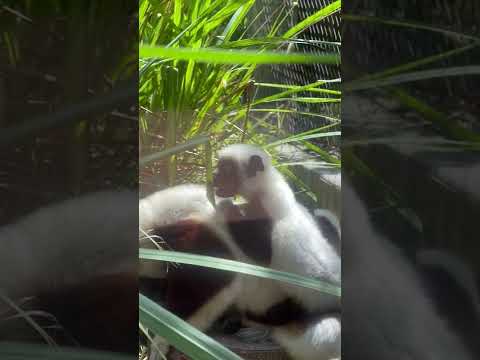Summary:
– Sifaka lemurs, including the Critically Endangered Sifaka Lemur Infant #shorts and Coqueral’s sifakas, are native to Madagascar and face a rapidly declining population.
– Unlike other lemurs, sifakas have a unique mode of locomotion where they pogo on their back legs, allowing them to spring through trees and on the ground.
– Emmett, a young sifaka lemur, is slowly gaining independence from his mother, Aemilia, but remains close by.
The enchanting world of lemurs is full of wonders and surprises, and none more so than the captivating Sifaka Lemur Infant #shorts and Coqueral’s sifakas. These beautiful creatures, native to the magical island of Madagascar, face an alarming threat to their existence as they stand on the brink of extinction. Every birth of these critically endangered lemurs brings hope for their species’ future and sustainability.
One of the most remarkable aspects that sets these lemurs apart from their relatives is their extraordinary mode of locomotion. While more than 100 species of lemurs move in various ways, the sifakas have embraced a truly unique approach. Picture this: a sifaka sitting upright, suddenly springing into action on their back legs, gracefully bounding through the trees and on the ground like a fantastical creature from a fairy tale.
Take, for instance, the young sifaka lemur named Emmett. This little bundle of joy is slowly gaining independence from his doting mother, Aemilia. However, Emmett is not one to wander far from his mother’s watchful eye. It’s heartwarming to witness their bond as they navigate their way through the lush forests of Madagascar.
Madagascar, known for its biodiversity and extraordinary wildlife, is a haven for these incredible creatures. Unfortunately, human activities such as deforestation, habitat destruction, and illegal hunting have pushed the sifakas to the edge of existence. As their population continuously declines, the importance of every birth cannot be overstated. Each new sifaka lemur brings a glimmer of hope and the potential to contribute to the survival of their species.
As lovers of nature and wildlife, we want to raise awareness about the plight of these incredible lemurs. We must take action to protect their habitats and support conservation efforts aimed at safeguarding their future. The more we learn about these magnificent creatures, the more invested we become in their survival.
So, what makes these lemurs so special? Aside from their stunning acrobatics and unique locomotion, they exhibit fascinating social behaviors. Sifakas, like many other lemur species, live in social groups known as troops. Each troop has a tight-knit social structure, with the alpha male and female leading the way.
Communal grooming is an integral part of these primates’ lives. They spend countless hours meticulously cleaning each other’s fur, a behavior that strengthens social bonds while keeping their coats in immaculate condition. At times, you might even glimpse them nibbling on leaves, performing an essential self-grooming to maintain their fur’s health and cleanliness.
The lemurs of Madagascar are also experts in communication. While they use various vocalizations to express themselves, their most astonishing means of communication lies in their scent marking. Sifakas use scent glands on their wrists and chests to assert their territory or attract potential mates to leave behind a distinct odor. This creates a complex olfactory map that can communicate vital information to other members of their troop.
Amidst the challenges facing the sifaka lemurs and their dwindling population, there is still hope. Conservation organizations and dedicated individuals work tirelessly to protect these extraordinary creatures and their habitats. By supporting these efforts, we can contribute to the preservation of lemurs and the vibrant ecosystems they rely on.
In conclusion, the Critically Endangered Sifaka Lemur Infant #shorts and Coqueral’s sifakas represent the fragile beauty of Madagascar’s remarkable wildlife. Their unique mode of locomotion, fascinating social behaviors, and incredible resilience in the face of adversity make them captivating subjects for study and conservation. We must cherish and protect these amazing lemurs, as every single birth holds the key to their species’ future and sustainability. Let us unite in our commitment to preserving the diversity of our planet, one lemur at a time.
*****
Source Description
Coqueral’s sifakas, like all lemurs, are native to Madagascar. They are listed as critically endangered with a continuously declining population. Every single birth is crucial to the species’ future and sustainability.
Unlike the more than 100 species of lemurs, sifaka’s have a different mode of locomotion — sitting upright, they pogo on their back legs, springing through trees and on the ground.
Emmett is becoming more independent from their mom, Aemilia, but never strays too far away!


